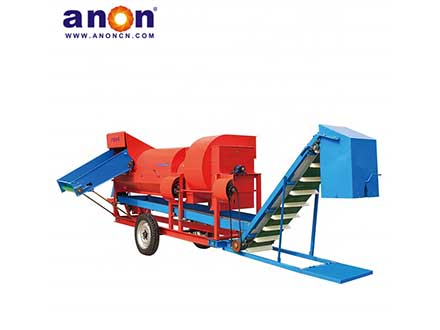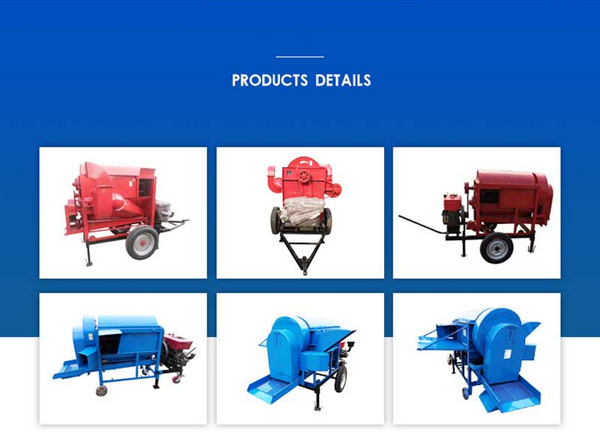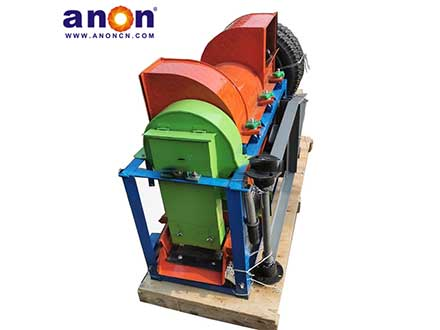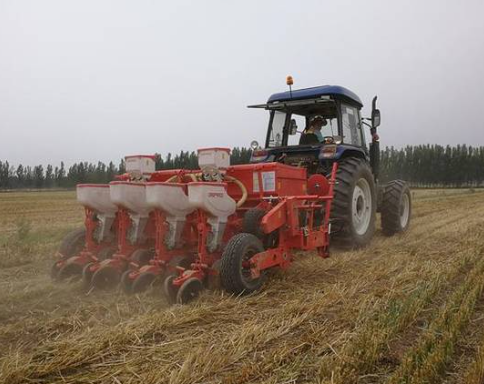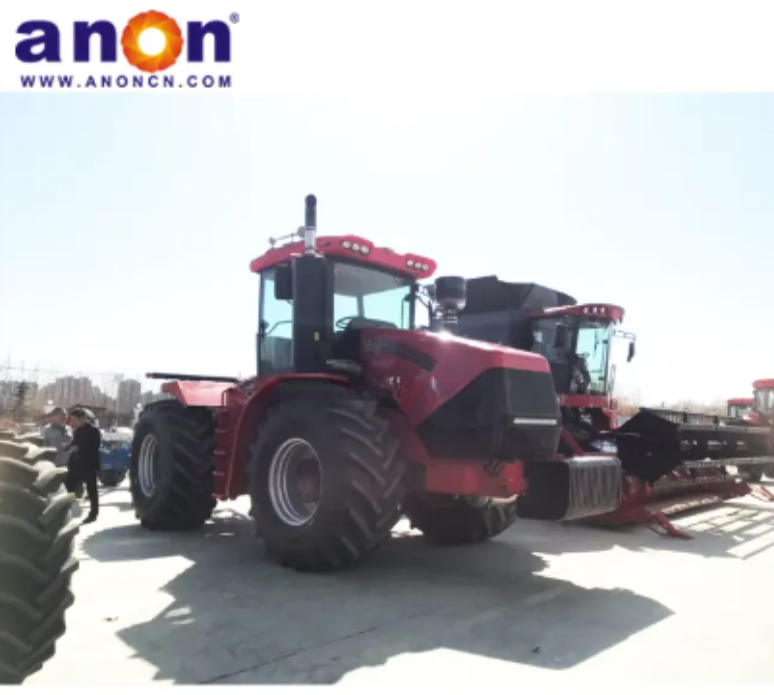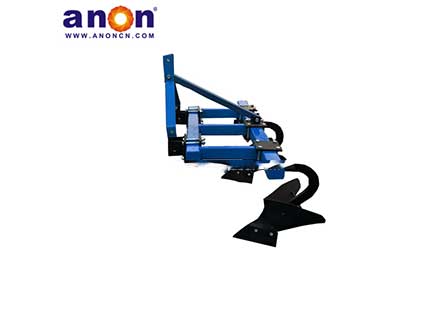Introduction
Farming requires a lot of labor. To solve this problem, people invented more and more agricultural machines, and threshing can be done using the threshing machine. It helps quickly remove grains or fruits from the stalks after harvest. In this article, I will explain this machine in detail to help you choose the right threshing machine.

What is a Threshing Machine?
A threshing machine is an important agricultural device that can separate grains or other fruits from stalks. It helps save people from heavy, complex tasks and greatly reduces labor. The design and function of the threshing machine can vary depending on the type of crop, so threshers are often classified into rice and wheat threshers, corn threshers, and peanut threshers.
Unlike corn and peanut threshers, which can only handle one type of crop, the rice and wheat thresher can process more crops by changing the screens. This is why people also call it a multi-purpose thresher. For example, they can use a fine screen for small grains like millet, rice, and canola, while a coarse screen can handle larger grains like soybeans and Job’s tears.
Threshing Machine: How it Works
The thresher machine design may vary. Next, I will explain the structure and working principles of rice and wheat threshers, corn threshers, and peanut threshers.
Parts of Thresher
Rice and Wheat Thresher
The main parts of a rice and wheat thresher include the feeding platform, frame, concave screen, drum, straw discharge opening, machine cover, main fan, engine, vibrating screen, grain outlet, and towing guide system.
Corn Thresher
The main parts of a corn thresher include the frame, feed inlet, threshing device, concave screen, vibrating screen, engine, corn kernel outlet, corn cob outlet, and fan.
Peanut Thresher
A peanut thresher, we also call a peanut picker, which consists of the frame, feed inlet, engine, transmission system, drum picking rods, concave holes, fan cleaning system, vibrating screen, and elevator.
How a Thresher Works?
Even though the thresher machine designs vary in type, the working steps can be divided into the threshing method of separation, winnowing method of separation, and sieving method of separation.
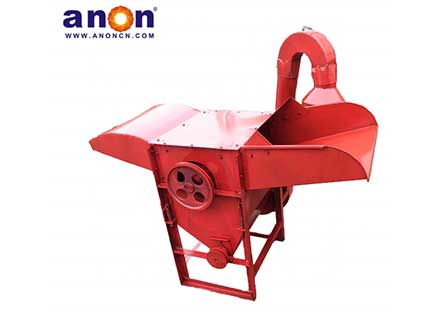
Rice and Wheat Thresher
When using a rice and wheat thresher, you place the grain onto the feeding platform, and it enters the threshing chamber. The V-belt drives the drum, causing it to spin at high speed. It works with the concave screen to rub and press the grain, separating the seeds from the straw.
Corn Thresher
When the corn thresher is working, you need to feed the corn cobs into the machine’s upper inlet. The cobs then fall into the threshing chamber due to gravity. The threshing mechanism consists of three metal rollers, each with a spiral beater, all connected by a central shaft. When the main shaft turns, it drives the rollers. The corn is then threshed by the friction and impact from the rollers, spiral beaters, and concave screens, causing the kernels to fall off the cob.
The kernels drop through the concave screen at the bottom of the threshing mechanism, while the fan blows any remaining impurities on the screen out through the cleaning outlet. Below the concave screen, there are two vibrating sieves: the top one has larger holes to separate the corn kernels, and the bottom one has finer holes to filter out dust. The fan blows the kernels out through the grain outlet, while the remaining corn cobs are expelled from the back of the threshing chamber.
Peanut Thresher
Feed the peanuts with vines into the peanut thresher through the feed inlet. Inside the threshing chamber, a drum with several picking rods spins at high speed, driven by the engine. The peanuts are separated from the vines through brushing and striking. The separated peanuts fall through the concave screen onto a vibrating screen. The fan blows away the weeds and leaves, while the peanuts drop onto the elevator. The machine then carries the peanuts to the top, and they fall into a bag that collects them. It discharges the peanut vines from the outlet.
The Advantages of Thresher
High Cleaning Ability
Whether you use a rice and wheat thresher, corn thresher, or peanut thresher, all of them come equipped with an air cleaning system. This system helps remove impurities mixed with the seeds and fruits as they separate from the stalks. The vibrating screen and airflow work together to ensure you get clean seeds and fruits.
Reduce Harvest Losses
Compared to traditional manual threshing methods, using a thresher can significantly reduce your harvest losses. Its rationally designed threshing drum and wind screen system achieves a high grain removal rate, minimizing residual grain. Optimized friction and impact intensity also effectively minimize grain breakage, ensuring grain integrity and quality. This high threshing rate and low breakage rate reduce your harvest losses.
Labor-saving
A thresher can quickly process large amounts of crops, and all you need to do is feed the crops into the machine without much effort. The threshing speed is much higher than doing it by hand. For example, the 80-type rice and wheat thresher can handle 700kg to 800kg of grain per hour. The extended version of the corn thresher can process 1,300kg to 1,800kg per hour. In the same amount of time, the thresher can do the work of dozens of people.
Affordable Prices
Threshers come in a range of sizes, from small to large, and can meet your threshing needs, whether it’s for a few acres or several hundred acres. Since threshers have simple designs, they usually don’t require a high initial investment. For most households, purchasing a small or medium-sized thresher is usually enough.
User-Friendly Design
Using a thresher is very user-friendly. Even if you have no experience, you can easily operate it by following the instructions. After assembling the thresher according to the manual, tighten the screws and adjust the V-belt. Then, run the machine empty for a test. Once everything is working properly, feed the dry crops into the machine’s feed inlet. Wait for 1 to 2 seconds before adding the next batch of crops. The operation is effortless.
Common Problems and Solutions For Thresher
Drum Clogging:
If you feed too many crops at once and the crops are too wet, you may slow down the machine’s speed or even clog the drum. You’d better dry the grain before threshing and feed the crops evenly in smaller amounts, with a 1-2 second gap between each feed.
Incomplete Threshing:
If the cleaning rate is much lower than what the machine is rated for, check if the crops are being fed unevenly or in too large amounts. And if those aren’t the issues, check the threshing gap. If the gap is too wide, the drum won’t rub and brush the crops effectively. You should adjust the gap to be smaller, but make sure it’s not less than 4mm, as this could cause too many seeds to break.
Poor Seed Cleanliness:
If you find that many impurities are mixed with the seeds, it could be because the fan isn’t generating enough airflow. Try tightening the fan belt. You can also control the amount of crops being fed to avoid too much straw, which can prevent the cleaning process from working properly.
Factors to Consider When Choosing a Threshing Machine
When you’re thinking about buying a thresher, you should consider the following factors to help you choose the machine that’s best for you.
Crop types
Before explaining how a thresher works, I introduced the structures of three different types of threshers. While they are generally similar, the key differences are important, such as the design of the threshing drum and the screens. We make these to match the specific characteristics of each crop, so you must choose the thresher based on the type of crop you are working with.
Power type
There are three types of power options for threshers: electric motor, gasoline engine, and diesel engine. The electric motor is best for places with a power supply, like at home. A gasoline or diesel engine would be a better choice if you’re using the thresher in an area without electricity. Gasoline threshers are usually better for personal or small-scale use, while diesel threshers are more suitable for large-scale farming because they provide more power.
Net Selection Rate and Total Loss Rate
When buying a threshing machine, you should consider two important parameters: cleaning and total loss rates. The cleaning rate refers to the percentage of the weight of cleaned seeds compared to the weight of the seeds fed into the machine. Typically, this should be at least 99%. The total loss rate indicates the amount of seed lost during the threshing process, including losses from incomplete threshing, seed mix, cleaning, and splashing. I recommend choosing a thresher with a total loss rate of 1% or less.
Conclusion
After reading this article, do you realize the threshing machine? Don’t hesitate anymore! With just one thresher, you can easily complete both threshing and cleaning. Don’t wait—take action now! Feel free to contact us at ANON for advice and to make your purchase!
FAQ
What does the threshing efficiency of the thresher depend on?
Factors like drum speed, drum type and diameter, concave screen area, and feeding amount can all affect the threshing performance.
Which threshing method is most efficient?
When operating at a speed of 1500rpm and a feed rate of 1.4kg/s, the drum thresher achieved the highest threshing efficiency and output of 99.07% and 2448kg/h, respectively.
What is the importance of threshing machines for farmers?
The use of threshers reduces the physical pressure on farmers, making the entire agricultural process more sustainable and reducing reliance on physical labor. Timely harvesting: Rice threshers can harvest rice in a timely manner, helping farmers avoid losses caused by excessive sowing or exposure to harsh weather conditions.




